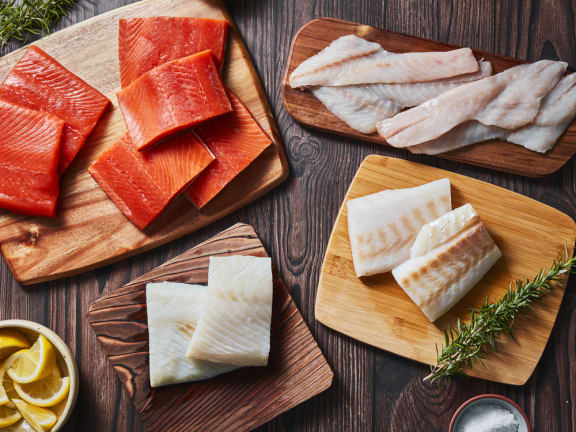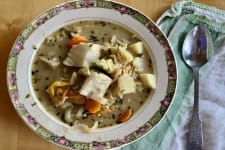
Best High-Protein Fish to Include in Your Diet
May 2nd, 2025Highest Protein Fish Options from Alaska
High-protein diets have become increasingly popular due to their associated health benefits and compatibility with a variety of dietary requirements. While many foods contain a good amount of protein, fish is often a key feature of high-protein diets. Many types of fish are relatively low in fat, making them excellent sources of lean, nutritious protein.
High-protein diets that include fish can help support overall health, as well as help you achieve specific health goals. A diet is considered high in protein if daily consumption exceeds 0.8g of protein per kg of bodyweight.1 For example, someone weighing 70kg (about 154lbs) would need to consume about 56g of protein per day to maintain a high-protein diet.
The broad range of benefits includes healthy weight loss and increased satiety. A high-protein diet may help support you if you’re following a muscle building program, helping you to replenish and recover.
What Makes Fish a High-Protein Food?
Any food source that contains 20 percent or more of the recommended daily intake of protein (as regulated by the FDA) is considered a high-protein source of food. Many species of fish are low in fat, and fish are not a source of carbohydrates. Generally, that means that you can expect a serving of fish to be made up of at least a good amount of protein.
Fish can contain varying amounts of protein, depending on the variety. Lean species of white fish can contain anywhere up to about 30 grams of protein per 6 oz. serving, while fattier types of fish like wild salmon contain around 35 grams of protein per 6 oz. serving.
For comparison, high-protein fish contain nearly double the amount of protein as a plant-based option like tofu or lentils — both of which contain around 15 grams of protein per 6 oz. serving. Land-based meats like beef or pork may contain more protein than fish, but they also tend to contain saturated fats that many nutritional experts suggest avoiding.
Nutritional Benefits of High-Protein Fish
Many varieties of high-protein fish are considered “healthy” options, due to their broader nutritional content. Unlike conventional land-based proteins like beef or pork, fish typically contains a low amount of saturated fat and cholesterol. Conversely, many types of high-protein fish contain omega-3 fatty acids like DHA and EPA. The benefits of omega-3s found in salmon and other foods may help support healthy cardiovascular function, normal cognitive function, and more.
Each type of high-protein fish also contains a different mix of essential nutrients such as vitamin A, vitamin D, and potassium. Enjoying a variety of species allows you to enjoy a broad variety of these nutrients.
Top High-Protein Fish Options
Here’s a general outline of protein content in Alaskan fish per 6 oz. serving, starting with the highest protein fish.
-
Salmon (wild-caught): 34g-37g protein
There are 5 different types of wild salmon in the Pacific, including sockeye, coho, and king salmon. Coho salmon has the most protein compared to other types of Pacific salmon. It’s also slightly higher in DHA, a type of omega-3 fatty acid. Sockeye is an excellent source of vitamin D, and it gets its rich red color from an antioxidant called astaxanthin. King salmon (chinook) is also rich in vitamin D, and despite being a lean protein has a delectable, buttery texture.
-
Pacific halibut: 30g protein
Pacific halibut is a classic lean white species of fish that is low in fat and calories, but high in protein. Compared to other types of white fish from Alaska, it contains the most protein. Its hearty texture makes it a great protein option when you’re craving fish with a meaty appeal.
-
Wild Alaska Pollock: 26g protein
Wild Alaska Pollock is an incredibly mild and flaky variety of white fish. It’s an especially affordable choice of high-protein fish, and highly versatile in the kitchen.
-
Pacific cod: 23g protein
Pacific cod is quite lean, containing a single gram of fat and only 100 calories per 6 oz. serving. It’s an ideal high-protein fish for calorie-restricted diets. However, it is suitable for any type of high-protein diet.
-
Sablefish (black cod): 21g protein
Compared to many types of white fish, sablefish is relatively fatty. Sablefish contains about as much EPA (a type of omega-3 fatty acid) as wild salmon, so it’s a good option for someone who wants to diversify the types of fats that are included in their high-protein diet.
How to Incorporate High-Protein Fish into Your Diet
There are many ways to include high-protein fish in your diet in a way that helps you increase your protein intake overall. Low mercury fish like wild salmon can be enjoyed on a regular basis — even children or people who are pregnant or nursing.
-
Try pairing any variety of fish with high-protein sides like lentils or quinoa.
-
Embrace meal prep! When stored properly in your refrigerator, freshly prepared fish can be stored for up to 3 days.
-
Start your day with fish. Adding high-protein fish to your first meal of the day is a great way to enjoy an extra serving of protein. Wild salmon is an especially good option, as it can be flaked into eggs or enjoyed on a piece of whole-grain toast.
Elevate Your Protein Intake with High-Quality Fish
There are so many varieties of fish that can help you increase your protein intake, from wild salmon to lean species of white fish. To get the most out of your dietary choices, it helps to choose high-quality options, since they contain essential nutrients that can help support overall health.
Stock your kitchen with high-quality, high-protein fish by sourcing your seafood online from Wild Alaskan Company. You’ll get wild-caught seafood delivered straight to your doorstep. Choose your fish subscription box today.





